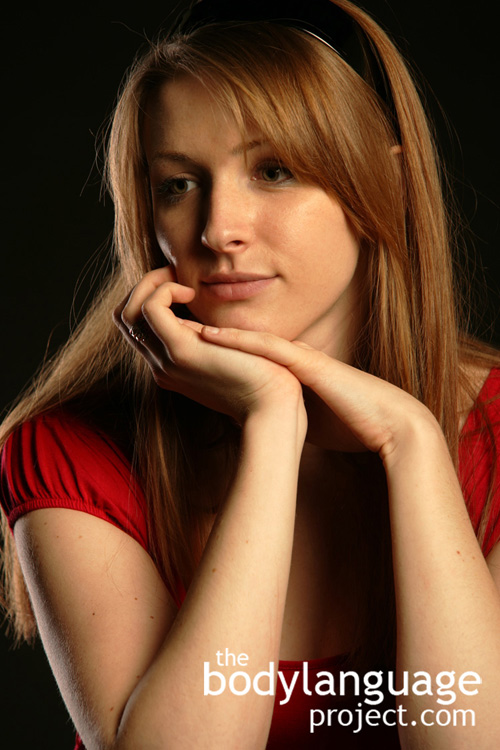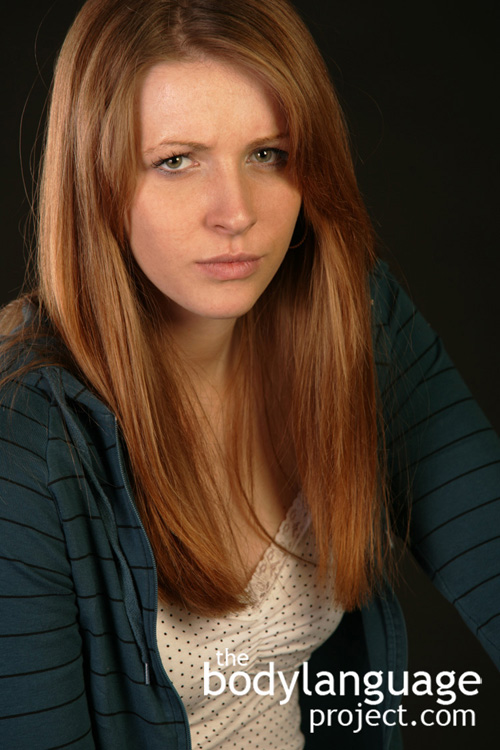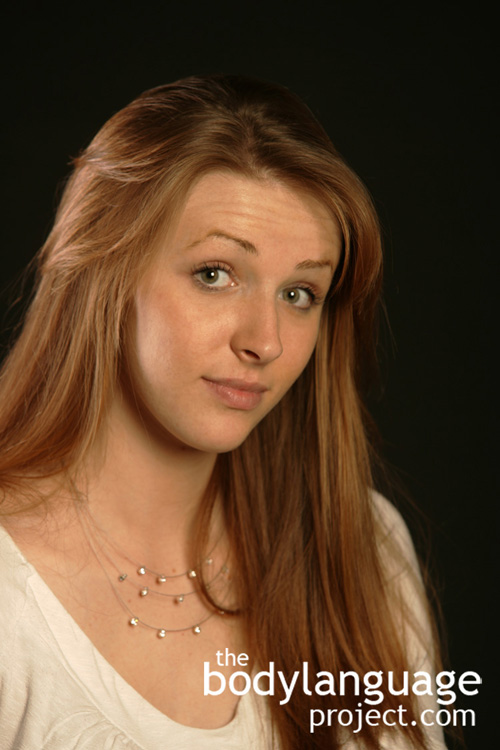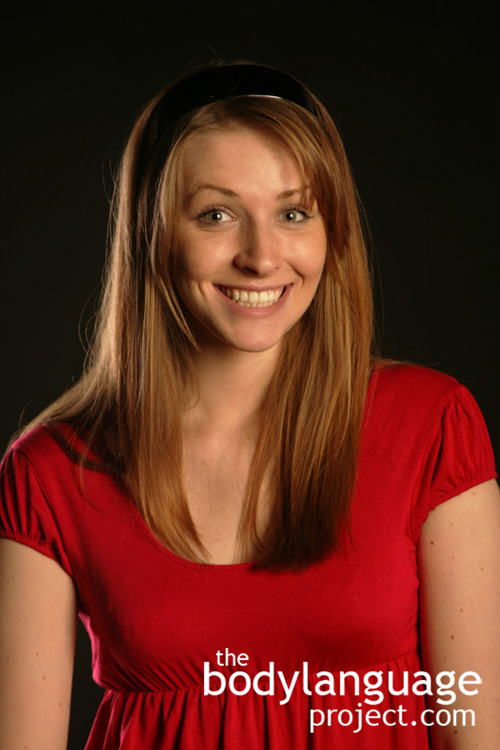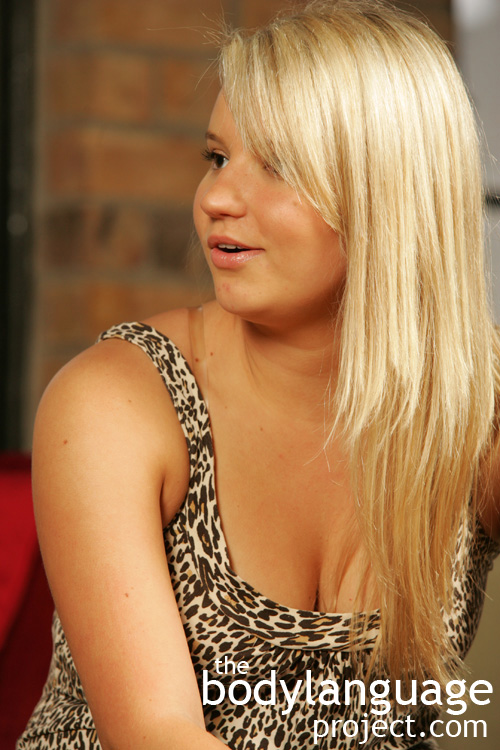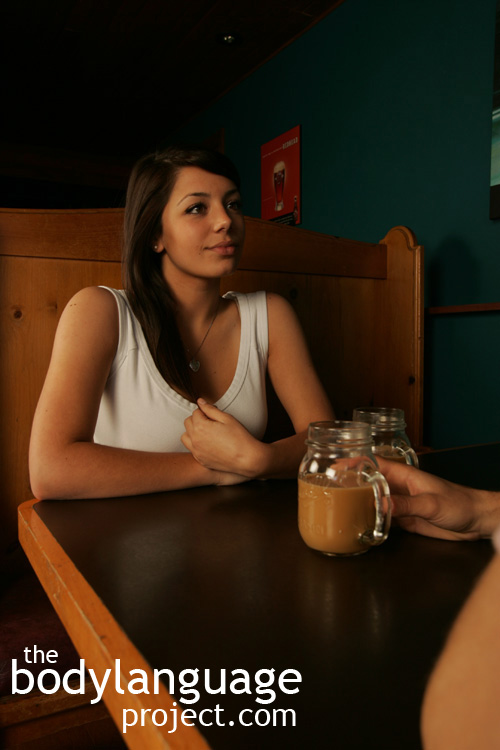Body Language of Eyebrow Raise
 Cue: Eyebrow Raise
Cue: Eyebrow Raise
Synonym(s): Raising The Eyebrows, Lifting The Eyebrows.
Description: Raising both eyebrows in unison.
In One Sentence: When the eyebrows rise in unison it signals excitement and surprise.
How To Use it: Raise your eyebrows when you want to tell other people that you find what they have said, or what you have said, surprising, shocking or exciting. A more expressive face helps people connect with you more easily as it helps build your personality. Women usually have a far easier time with these sorts of facial expressions, but men can also benefit especially when they are trying to connect with other women and children.
Context: General.
Verbal Translation: “My eyebrows are bopping up and down in unison with my speech to emphasis points and produce emotion and expression.”
Variant: See Eyebrow Cock, Eyebrow Hold, Eyebrow Lowering, Eyebrow Flash, Eyebrows Knit or Oblique Eyebrows Of Grief.
Cue In Action: The news reporter raised her eyebrows as she punctuated each news item to show emphasis.
Meaning and/or Motivation: Eyebrows that rise are an indication of excitement. When we speak, we show our enthusiasm more frequently than a full surprise or fear expression, which also has the raises the eyebrows. If you watch closely, you will see a person’s eyebrows rise several times as they deliver their story. It is more common in woman than men.
Eyebrows can also rise to show agreement or to emphasize and punctuate points in speech. The eyebrows frequently rise at the end of questions, as if asking others to clarify. Where eyebrows lower, it signifies dominance, whereas eyebrows raised signals a mild submission and an open facial expression. When one eyebrow rises, the eye cock, it shows suspicion.
Cue Cluster: When eyebrows rise, the eyes also tend to pop open as well. This cue cluster seeks to improve vision, often accompanying surprise.
Body Language Category: Amplifier, Eye Language, Microexpressions, Open facial gestures, Submissive body language, Surprised body language.
Resources:
Aviezer, Hillel; Ran R. Hassin; Jennifer Ryan; Cheryl Grady; Josh Susskind; Adam Anderson; Morris Moscovitch and Shlomo Bentin. Angry, Disgusted, or Afraid? Studies on the Malleability of Emotion Perception. Psychological Science. 2008. 19(7): 724-732.
http://bodylanguageproject.com/articles/emotions-read-context-study/
App, Betsy; Catherine L. Reed and Daniel N. McIntosh. Relative Contributions Of Face And Body Configurations: Perceiving Emotional State And Motion Intention. Cognition and Emotion. 2012. 26(4): 690-698.
http://bodylanguageproject.com/articles/facial-expressions-versus-bodily-expressions-nonverbal-communication/
Aaron, Sell; Cosmides, Leda and Tooby, John. The Human Anger Face Evolved to Enhance Cues of Strength. Evolution and Human Behavior. 2014. 35(5): 425-429.
http://bodylanguageproject.com/articles/the-universal-anger-face/
Ben-Zeev, Avi; Tara C. Dennehy; Rachel Sackman; Andres Olide and Christopher C. Berger. Flirting With Threat: Social Identity and the Perils of the Female Communality Prescription. Journal of Experimental Social Psychology. 2011. 47: 1308-1311.
http://bodylanguageproject.com/articles/flirting-with-danger-women-flirt-to-avoid-conflict/
Bard, K. A. (2003). Development of emotional expressions in chimpanzees (Pan troglodytes). In P. Ekman, J. Campos, R. J. Davidson & F. B. M. De Waal (Eds.), Emotions inside out: 130 years after Darwin’s The Expression of the Emotions in Man and Animals (Vol. 1000, pp. 88-90). New York: Annals of the New York Academy of Sciences.
Baron, R. M., & Kenny, D. A. (1986). The moderator-mediator variable distinction in social psychological research: Conceptual, strategic, and statistical considerations. Journal of Personality and Social Psychology, 51(6), 1173-1882.
Biehl, M., Matsumoto, D., Ekman, P., Hearn, V., Heider, K., Kudoh, T., et al. (1997). Matsumoto and Ekman’s Japanese and Caucasian Facial Expressions of Emotion (JACFEE): Reliability Data and Cross-National Differences. Journal of Nonverbal Behavior, 21, 3-21.
Carroll E. 1994. Innate and universal facial expressions: Evidence from developmental and cross-cultural research Izard, Psychological Bulletin. 115(2): 288-299.
Daniel H. Lee, Reza Mirza, John G. Flanagan and Adam K. Anderson. Optical Origins of Opposing Facial Expression Actions. Psychological Science published online 24 January 2014 DOI: 10.1177/0956797613514451
http://bodylanguageproject.com/articles/eyes-and-facial-expressions-may-be-biologically-controlled-serve-a-real-non-emotional-purpose-says-research/
de Waal, F. B. M. (2003). Darwin’s legacy and the study of primate visual communication. In P. Ekman, J. Campos, R. J. Davidson & F. B. M. De Waal (Eds.), Emotions inside out: 130 years after Darwin’s The Expression of Emotion in Man and Animals (pp. 7-31). New York: New York Academy of Sciences.
Duan, Xujun ; Dai, Qian ; Gong, Qiyong ; Chen, Huafu. Neural mechanism of unconscious perception of surprised facial expression. NeuroImage. 2010. 52(1): 401-407.
e Charlesworth, W. R. (1964). Instigation and maintenance of curiosity behavior as a function of surprise versus novel and familiar stimuli. Child Development, 35, 1169–1186.
Ekman, P. & O’Sullivan, M. (1991). Who can catch a liar? American Psychologist. 46, 913-920.
Ekman, P., Friesen, W. V., O’Sullivan, M., Chan, A., Diacoyanni-Tarlatzis, I., Heider, K., et al. (1987). Universals and cultural differences in the judgments of facial expressions of emotion. Journal of Personality & Social Psychology, 53(4), 712-717.
Ekman, P., Levenson, R. W., & Friesen, W. V. (1983). Autonomic nervous system activity distinguishes among emotions. Science, 221(4616), 1208-1210.
Ekman, P., O’Sullivan, M., & Matsumoto, D. (1991a). Confusions about context in the judgment of facial expression: A reply to “The contempt expression and the relativity thesis.”. Motivation & Emotion, 15(2), 169-176.
Ekman, P., O’Sullivan, M., & Matsumoto, D. (1991b). Contradictions in the study of contempt: What’s it all about? Reply to Russell. Motivation & Emotion, 15(4), 293-296.
Elfenbein, H. A., & Ambady, N. (2002). On the universality and cultural specificity of
emotion recognition: A meta-analysis. Psychological Bulletin, 128(2), 205-235.
Ekman, Paul. 1994. Strong evidence for universals in facial expressions: A reply to Russell’s mistaken critique Psychological Bulletin. 115(2): 268-287.
Ekman, Paul. 1986. A new pan-cultural facial expression of emotion. Source: Motivation and Emotion Ekman. 10(2): 159-168.
Ekman, Paul and Friesen, W. V. 1987. Universals and cultural differences in the judgments of facial expressions of emotion. Journal of Personality and Social Psychology. 53(4): 712-717.
Ekman, Paul; Friesen, Wallace V. 1971. Constants across cultures in the face and emotion. Journal of Personality and Social Psychology. 17(2): 124-129.
Ekman, Paul. 1972. Universals and cultural differences in facial expressions of emotion. In J. Cole (Ed.), Nebraska Symposium on Motivation, 1971. 19: 207-282. Lincoln: University of Nebraska Press.
Fulcher, J. S. “Voluntary” facial expression in blind and seeing children. Archives of Psychology, 1942. 38: 272.
Friesen, W. V. 1972. Cultural differences in facial expressions in a social situation: An experimental test of the concept of display rules. Unpublished doctoral dissertation, University of California, San Francisco.
Grezes, Julie; Le´onor Philip; Michele Chadwick; Guillaume Dezecache; Robert Soussignan and Laurence Conty. Self-Relevance Appraisal Influences Facial Reactions to Emotional Body Expressions. PLoS ONE. 2013. 8(2): e55885. doi:10.1371/journal.pone.0055885
http://bodylanguageproject.com/articles/face-reacts-body-anger-brains-wired-process-emotional-body-language
Hall, Judith ; LeBeau, Lavonia ; Reinoso, Jeannette ; Thayer, Frank. Status, Gender, and Nonverbal Behavior in Candid and Posed Photographs: A Study of Conversations Between University Employees. Sex Roles. 2001 44(11): 677-692.
Hatz, Jessica L. and Martin J. Bourgeois. Anger as a Cue to Truthfulness. Journal of Experimental Social Psychology. 2010. 46: 680-683.
http://bodylanguageproject.com/articles/anger-nonverbal-cue-truth-telling/
Hareli, Shlomo; Noga Shomrat and Ursula Hess. Emotional Versus Neutral Expressions and Perceptions of Social Dominance and Submissiveness. Emotion. 2009 9(3): 378-384. DOI: 10.1037/a0015958
http://bodylanguageproject.com/articles/dominance-expression-conveyed-different-facial-expressions-men-women/
James A. Russell, Naoto Suzuki and Noriko Ishida. 1993. Canadian, Greek, and Japanese freely produced emotion labels for facial expressions. Motivation and Emotion. 17(4): 337 -351
Kret, Mariska Esther and Beatrice de Gelder. Social Context Influences Recognition of Bodily Expressions. Exp Brain Res. 2010. 203:169-180. DOI 10.1007/s00221-010-2220-8
http://bodylanguageproject.com/articles/context-matters-judging-body-language/
Levenson, R. W., Ekman, P., & Friesen, W. V. (1990). Voluntary facial action generates emotion-specific autonomic nervous system activity. Psychophysiology, 27(4), 363-384.
Levenson, R. W., Ekman, P., Heider, K., & Friesen, W. V. (1992). Emotion and autonomic nervous system activity in the Minangkabau of West Sumatra. Journal of Personality & Social Psychology, 62(6), 972-988.
Ludden, G. D. S., Schifferstein, H. N. J., & Hekkert, P. (2009). Visual–tactual incongruities in products as sources of surprise. Empirical Studies of the Arts, 27, 63–89.
Marzoli, Daniele; Mariagrazia Custodero; Alessandra Pagliara and Luca Tommasi. Sun-Induced Frowning Fosters Aggressive Feelings. Cognition And Emotion. 2013; 27 (8): 1513-1521.
http://bodylanguageproject.com/articles/avoid-anger-sunny-days/
Mondloch, Catherine J.; Nicole L. Nelson and Matthew Horner. Asymmetries of Influence: Differential Effects of Body Postures on Perceptions of Emotional Facial Expressions. PLOS one. September 2013. 8(9): e73605.
http://bodylanguageproject.com/articles/facial-expressions-versus-bodily-expressions-nonverbal-communication-2
McClure, Erin B 2000. A meta-analytic review of sex differences in facial expression processing and their development in infants, children, and adolescents
Psychological Bulletin. 126(3): 424-453.
Mead, M. 1975. Review of “Darwin and facial expression.” Journal of Communication, 25: 209-213.
Matsumoto, D. (1989). Cultural influences on the perception of emotion. Journal of Cross-Cultural Psychology, 20(1), 92-105.
Matsumoto, D. (1992). American-Japanese cultural differences in the recognition of universal facial expressions. Journal of Cross-Cultural Psychology, 23(1), 72-84.
Matsumoto, D. (2001). Culture and Emotion. In D. Matsumoto (Ed.), The Handbook of Culture and Psychology (pp. 171-194). New York: Oxford University Press.
Matsumoto, D., & Ekman, P. (1989). American-Japanese cultural differences in intensity ratings of facial expressions of emotion. Motivation & Emotion, 13(2), 143-157.
Matsumoto, D., Keltner, D., Shiota, M. N., Frank, M. G., & O’Sullivan, M. (2008). What’s in a face? Facial expressions as signals of discrete emotions. In M. Lewis, J. M. Haviland & L. Feldman Barrett (Eds.), Handbook of emotions (pp. 211-234). New York: Guilford Press.
Matsumoto, D., & Willingham, B. (2009). Spontaneous Facial Expressions of Emotion of Congenitally and Non-Congenitally Blind Individuals. Journal of Personality and Social Psychology, 96(1), 1-10.
Mesquita, B., & Frijda, N. H. (1992). Cultural variations in emotions: A review. Psychological Bulletin, 112, 197-204.
Morris, Desmond (1994). Bodytalk: The Meaning of Human Gestures (New York: Crown Publishers).
Nao, Misako Sawada and Motonobu Ishii. Development of the Movements Impressions Emotions Model: Evaluation of Movements and Impressions Related to the Perception of Emotions in Dance. Journal of Nonverbal Behavior. 2013. 37:107-121.
DOI 10.1007/s10919-013-0148-y
http://bodylanguageproject.com/articles/convey-emotion-nonverbally-dance-study/
Parzuchowski, Michal ; Szymkow-Sudziarska, Aleksandra. Well, slap my thigh: expression of surprise facilitates memory of surprising material. Emotion. 2008. 8(3): 430-4.
Peleg, G., Katzir, G., Peleg, O., Kamara, M., Brodsky, L., Hel-Or, H., et al. (2006). Heriditary family signature of facial expression. Proceedings from the National Academy of Sciences, 103(43), 15921-15926.
Russell, James A. 1995. Facial Expressions of Emotion: What Lies Beyond Minimal Universality? Psychological bulletin. 118(3): 379-391.
Russell, James A. 1994. Is There Universal Recognition of Emotion From Facial Expression? A Review of the Cross-Cultural Studies. Psychological Bulletin. 115(1): 102-141.
Reed, Lawrence, Ian; Peter DeScioli and Steven A. Pinker. The Commitment Function of Angry Facial Expressions. Psychological Science. 2014 DOI: 10.1177/0956797614531027
http://bodylanguageproject.com/articles/anger-facial-expression-gets-people-to-do-what-you-want/
Reisenzein, R. (2000). Exploring the strength of association between the components of emotion syndromes: the case of surprise. Cognition and Emotion, 14, 1–38.
Reisenzein, R., Bördgen, S., Holtbernd, T., & Matz, D. (2006). Evidence for strong dissociation between emotion and facial displays: the case of surprise. Journal of Personality and Social Psychology, 91, 295–315.
Reisenzein, R., & Studtmann, M. (2007). On the expression and experience of surprise: no evidence for facial feedback, but evidence for a reverse self-inference effect. Emotion, 7, 612–627.
Scherer, K. R., Zentner, M. R., & Stern, D. (2004). Beyond surprise: the puzzle of infants’ expressive reactions to expectancy violation. Emotion, 4, 389–402.
Schützwohl, Achim ; Reisenzein, Rainer. Facial expressions in response to a highly surprising event exceeding the field of vision: a test of Darwin’s theory of surprise. Evolution and Human Behavior. 2012. 33(6): 657-664.
Stienen, Bernard M. C.; Akihiro Tanaka and Beatrice de Gelder. Emotional Voice and Emotional Body Postures Influence Each Other Independently of Visual Awareness. PLoS ONE. 2011. 6(10): e25517. doi:10.1371/journal.pone.0025517.
http://bodylanguageproject.com/articles/body-language-read-quickly-subconsciously-study/
Sinke, C.B, Sorger, B, Goebel, R, and de Gelder, B. Tease or Threat? Judging Social Interactions From Bodily Expressions. Neuroimage. A Journal of Brain Function. 2009. 49:1717-1727. doi: 10.1016/j.neuroimage.
http://bodylanguageproject.com/articles/friend-foe-let-body-language-decide
Schubert, Thomas W. The Power In Your Hand: Gender Differences In Bodily Feedback
From Making a Fist. Society for Personality and Social Psychology. 2004. 30(6): 757-769. DOI: 10.1177/0146167204263780
http://bodylanguageproject.com/articles/men-view-power-body-language-different-women-bodily-feedback-making-fist/
Susskind, Joshua M and Adam K Anderson. Facial Expression Form and Function. Communicative Integrative Biology. 2008. 1(2): 148–149. PMCID: PMC2686004
http://bodylanguageproject.com/articles/emotional-facial-expressions-evolve/
Sell, A., Cosmides, L. and Tooby, J., The Human Anger Face Evolved to Enhance Cues of Strength. Evolution and Human Behavior. 2014, doi: 10.1016/j.evolhumbehav.2014.05.008
http://bodylanguageproject.com/articles/human-anger-face-signal-strength
Teixeira Fiquer, Juliana; Paulo Sérgio Boggio and Clarice Gorenstein. Talking Bodies: Nonverbal Behavior in the Assessment of Depression Severity. Journal of Affective Disorders. 2013. 150: 1114-1119.
http://bodylanguageproject.com/articles/using-nonverbal-behaviour-to-assess-depression-severity/
Thompson, Erin H. and James A. Hampton. The Effect of Relationship Status on Communicating Emotions Through Touch,. Cognition and Emotion. 2011. 25(2): 295-306. DOI: 10.1080/02699931.2010.492957.
http://bodylanguageproject.com/articles/using-touch-convey-emotion/
Wilkowski, Benjamin M. and Brian P. Meier. Bring It On: Angry Facial Expressions Potentiate Approach-Motivated Motor Behavior. 2010. Journal of Personality and Social Psychology. 98(2): 201-210.
http://bodylanguageproject.com/articles/anger-facial-expression-elicits-approach-not-avoidance-study/
Zieber, Nicole; Ashley Kangas; Alyson Hock; and Ramesh S. Bhatt. Infants’ Perception of Emotion From Body Movements. Child Development. 2014. 85(2): 675-684.
http://bodylanguageproject.com/articles/careful-infants-perceptive-reading-body-language/
Zhao, Ke; Wen-Jing Yan; Yu-Hsin Chen; Xi-Nian Zuo and Xiaolan Fu. Amygdala Volume Predicts Inter-Individual Differences in Fearful Face Recognition. PLOS one. August 2013. (8): 8: e74096. doi:10.1371/journal.pone.0074096.g001
http://bodylanguageproject.com/articles/fear-amygdala
Vrticka, Pascal ; Lordier, Lara ; Bediou, Benoît ; Sander, David Desteno, David (editor). Human Amygdala Response to Dynamic Facial Expressions of Positive and Negative Surprise. Emotion. 2014. 14(1): 161-169.
Vanhamme, J. (2000). The link between surprise and satisfaction: an exploratory research on how to best measure surprise. Journal of Marketing Management, 16, 565–582.

